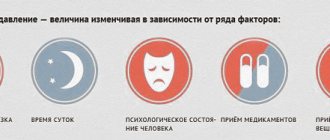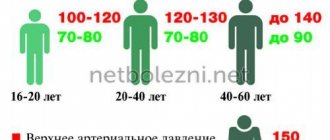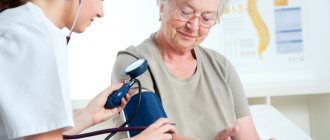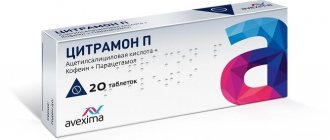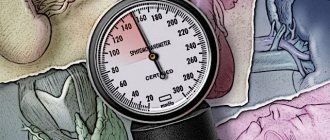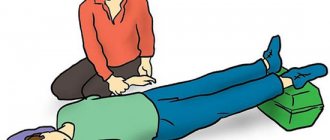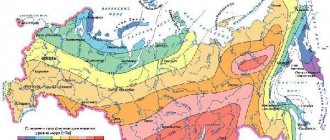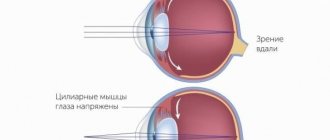Normal blood pressure: what is upper and lower pressure
Blood pressure is measured using a device called a tonometer. A cuff (a wide band that compresses) is placed on the arm. This cuff is attached to a device that measures the pressure inside your arteries. When you turn on the blood pressure monitor, the cuff tightens and then slowly relaxes again. It's quick and painless. Eventually, the device will show your blood pressure.
Blood pressure is measured in millimeters of mercury. The blood pressure reading consists of two numbers, for example 120/75. The first (top) number is the pressure when the heart beats (systolic pressure). The second (lower) number is when the heart relaxes (diastolic pressure).
High blood pressure usually does not cause symptoms. The only way to know if your blood pressure is elevated is to measure it. For example, a value of 110/70 is within the normal range for blood pressure; 126/72 – high blood pressure; value 135/85 – stage 1 hypertension (mild), etc. (see table).
Is your blood pressure going up?
To make a diagnosis and provide the necessary assistance, a neurologist will listen to your complaints, conduct an examination and a comprehensive neurological examination, which includes:
- collection of anamnesis of the disease (conversation);
- special neurological tests;
- reflex diagnostics;
- local palpation examination of the spine and musculoskeletal system.
In addition to the main examination, if necessary, the doctor may prescribe:
- MRI;
- Ultrasound;
- X-ray;
- Lab tests;
- EEG;
What causes high blood pressure
For most people, there is no single cause for high blood pressure. However, there are a number of factors that increase the likelihood of developing hypertension. These are the so-called risk factors - controllable and uncontrollable. You can adjust:
- . When a person smokes, the incoming nicotine increases blood pressure. Over time, this damages the arteries, increasing the risk of heart attack or stroke.
- Eating excess processed foods and salt. Many processed foods contain a lot of salt. Excess salt intake causes the body to store excess water, which increases blood pressure.
- Drinking excess alcohol too often. Drinking alcohol temporarily increases blood pressure. Excessive alcohol consumption on a regular basis can lead to hypertension.
- Excess weight. Excess weight increases the risk of high blood pressure. Even losing just a few pounds can lower your blood pressure.
- Insufficient activity. If a person moves more and sits less, blood pressure decreases.
- . Hormones produced by the body during stress increase blood pressure. Researchers are still trying to understand the exact link between long-term high blood pressure and ongoing stress.
Uncontrollable risk factors include:
- . If a patient has type 1 or type 2 diabetes, they are twice as likely to develop high blood pressure.
- Kidney disease or other gland problems. Sometimes a serious disease that affects the kidneys, arteries, heart, or endocrine system can cause high blood pressure.
- Aging. Blood pressure naturally increases with age.
- Taking certain medications, such as birth control pills.
- A parent or sibling with high blood pressure. High blood pressure runs in families, so if parents or siblings have problems, the risk of hypertension increases.
What pressure is considered high
Provoking factors that cause increased blood pressure include:
- At a young age: smoking, addiction to alcohol, drug use, congenital anomaly of the renal vessels, vegetative-vascular dystonia, pathology of the adrenal glands, pituitary gland.
- With age, the role of obesity, endocrine pathologies (diabetes mellitus, hyperthyroidism), diseases of the cardiovascular system, kidneys, and in women - hormonal imbalance during menopause, and neuropsychic overload increases in the development of hypertension.
- In old and senile age, atherosclerotic changes in blood vessels come to the fore.
Arterial hypertension is diagnosed when systolic and diastolic pressure levels are equal to or greater than 140/90 mmHg. Art.
A persistent increase in systolic and diastolic pressure by 5-10 mmHg. Art. increases the incidence of strokes by 30-40%, and heart attacks by 25-30%.
Symptoms of high blood pressure
High blood pressure is often called the "silent killer" because in most cases it causes no symptoms. The only way to find out if it is there is to measure it with a tonometer. High blood pressure can sometimes be accompanied by one or more of the following symptoms:
- Strong headache;
- dyspnea;
- dizziness;
- nosebleeds;
- severe anxiety.
Usually the headache is in the back of the head; during crises, one often feels dizzy and is accompanied by nausea and vomiting.
We use treatment methods such as:
- Manual therapy;
- Osteopathy - treatment by the hands of a doctor, a gentle effect on the musculoskeletal system, nervous and vascular systems, internal organs;
- Medical massage;
- Acupuncture - exposure to biologically active points with microneedles;
- Laser reflexology is a painless effect on reflexogenic zones and points;
- Tsubotherapy is a gentle effect on the body’s reflex points;
- Pharmacopuncture - the introduction of medicinal drugs of natural origin to the source of the problem;
- Plasma therapy is the introduction of the patient’s own purified blood into the site of the disease;
- Isometric kinesiotherapy - individual gymnastic techniques/exercises, according to indications, with elements of joint massage;
- Kinesiotherapy using the Exart installation;
- Kinesio taping;
- Ozone therapy - treatment with active oxygen;
- Physiotherapy;
- Physiotherapy with enzyme preparations;
- Therapeutic droppers;
- Hirudotherapy - treatment with leeches;
- Botulinum therapy is treatment with botulinum toxin preparations.
What to do with high blood pressure
There are two types of hypertensive crises - both require immediate attention, as they threaten serious complications. It is important to know what to do if you have high blood pressure at home, and how to provide first aid.
If your blood pressure is 180/120 or higher, wait about five minutes and try again. If the second reading is as high and you do not experience any other associated end-organ symptoms such as chest pain, shortness of breath, back pain, numbness or weakness, vision changes or difficulty speaking, it will be considered an uncomplicated hypertensive crisis . Your doctor may simply adjust or add medications, but the condition rarely requires hospitalization.
If your blood pressure is 180/120 or higher, a high pulse with high blood pressure, you are experiencing any other symptoms of end organ damage such as chest pain, shortness of breath, back pain, numbness/weakness, vision changes, or difficulty with a speech, it is important to know what to do. This is a complicated crisis. Don't wait for your blood pressure to drop on its own; call an ambulance.
Reducing blood pressure at home
Many people who have not previously experienced problems with blood pressure or simply did not pay attention to headaches and other symptoms usually do not know what to do if the tonometer readings confirm unpleasant fears. The main rules of behavior: calm and deep breathing. To make it easier for the brain to receive oxygen, the apartment of a hypertensive patient should be well ventilated. A cold compress on the neck and forehead will help relieve the condition.
As a one-time help, you can take a drug from the group of angiotensin-converting enzyme blockers in combination with an anesthetic drug (paracetamol, ibuprofen). However, cardiologists do not recommend treatment in this way on a regular basis. The choice of medications to lower blood pressure should be agreed with a doctor - he will be the one who will help you choose the necessary drug, which should always be in your home medicine cabinet.
Pills and medicines
Drugs to lower blood pressure are divided into several groups. Let's look at them in detail.
ACE inhibitors
Angiotensin-converting enzyme inhibitors are one of the most popular drugs in the treatment of hypertension. These drugs interfere with the conversion of the enzyme angiotensin 1 to angiotensin 2, which narrows the lumen of blood vessels. The mechanism is simple: the blood vessels do not narrow - the pressure does not increase. There is also a gradation among ACE inhibitors:
- First generation drugs: Captopril, Benazepril, Zofenopril.
- Second generation drugs: Lisinopril, Ramipril, Enalapril.
- Third generation drugs: Monopril, Fozinap, Fozinotec.
Alpha blockers
The sympathetic-adrenal system is responsible for changes in blood pressure in the body. The adrenal glands and hypothalamus produce adrenaline and norepinephrine, neurotransmitters that, among other things, regulate the functioning of the cardiovascular system. They stimulate the heart rate and increase blood pressure.
Alpha blockers, as the name suggests, help reduce the sensitivity of specific alpha receptors to adrenaline and norepinephrine, thereby reducing blood pressure. The most well-known drugs are Doxazosin and Prazosin.
Beta blockers
Unlike alpha-blockers, drugs in this group block beta receptors located not only in the arteries, but also in the heart. The principle of action is the same, as well as the therapeutic effect: dilation of blood vessels, facilitation of blood flow and subsequent decrease in pressure, as well as a decrease in the frequency and force of contraction of the heart muscle. Preparations:
- Bisoprolol,
- Betaxolol,
- Metoprolol,
- Nebivolol.
Diuretics
Due to their diuretic effect, diuretics reduce the load on the heart. In addition, they have a vasodilating effect, which, as we already know, is also used to reduce blood pressure. Experts have different opinions regarding the use of diuretics to lower blood pressure: some consider them first-line drugs along with adrenergic blockers, others are convinced that the use of diuretics in the treatment of hypertension is a thing of the past, since drugs in this group disrupt the electrolyte balance. The following groups of diuretics are distinguished:
- Loopbacks. They have a strong but short-term effect. In the treatment of arterial hypertension, they are used in patients with renal failure. The most commonly used are Furosemide and Torasemide.
- Potassium-sparing. Unlike other diuretics, they do not remove potassium from the body, although their diuretic effect is slightly weaker. Drugs: Spironolactone, Amiloride.
- Thiazide. This type of diuretic is used most often in the treatment of hypertension. The potency of action is inferior to loop diuretics, but superior to potassium-sparing diuretics. The most common drugs: Hydrochlorothiazide, Cyclopenthiazide.
- Osmotic. This type of diuretic for hypertension is prescribed much less frequently and is usually used in hospital treatment. The most commonly used are Sorbitol and Mannitol.
Calcium antagonists
Since imbalance of calcium and its excess in the blood plasma is considered a predisposing factor to increased blood pressure, drugs of this group are actively used in the treatment of hypertension. They prevent calcium from entering cells, thereby normalizing blood pressure. And there is a gradation here:
- Dihydropyrines: Amlodipine, Nifedipine.
- Phenylalkylamines: Verapamil, Gallopamil.
- Benzodiazepines: Diltiazem, Clentiazem.
Heart medications for high blood pressure
For hypertension, ACE inhibitors, alpha-blockers, beta-blockers and calcium antagonists are used - all of them are “heart” drugs, since they are prescribed in the treatment of pathologies such as coronary heart disease, left ventricular dysfunction and chronic heart failure. In addition to the medications already listed above, you can add here:
- Lercanidipine,
- Valsartan,
- Aliskiren,
- Carvedilol.
The choice of medications to lower blood pressure should be agreed with your doctor. Photo: towfiqu999 / freepik.com
Folk remedies for quickly reducing blood pressure
If there are no medications at hand, and the increase in pressure does not indicate a hypertensive crisis, you can use traditional methods, although they are inferior in effectiveness to drug treatment. Here are some of the most common methods:
- Mustard plasters on the shin. Due to blood flow to the legs, a slight hypotensive effect is achieved.
- Compress with apple cider vinegar. Folded gauze or a towel is soaked in apple cider vinegar and applied to the feet. From the point of view of evidence-based medicine, the method is questionable, but some patients claim that it has an effect.
- Breathing exercises. For several minutes, you need to inhale and exhale slowly, taking a comfortable position and closing your eyes. Exhale should be done with the stomach, not the chest. This relieves nervous tension and improves peripheral blood supply.
- Pressure also helps reduce massage of the collar area. However, unlike the classic version, stroking movements should be performed with a little more pressure and directed downwards - from the neck to the lower back.
High blood pressure danger
A hypertensive crisis (high blood pressure or BP) is a condition when blood pressure rises quickly and sharply, with readings of 180/120 or higher. The consequences of uncontrolled blood pressure in this range can be serious and include:
- stroke;
- loss of consciousness with dangerous injuries;
- memory loss;
- acute cardiovascular diseases;
- eye damage and visual disturbances;
- loss of kidney function;
- aortic dissection;
- angina pectoris (unstable chest pain);
- Pulmonary edema (fluid reserve in the lungs).
If you have been diagnosed with high blood pressure, monitor your readings and take your medications. During an emergency, having the notes with you can provide valuable information to the medical team providing treatment.
Causes of pressure surges
Probably, more than once, everyone who suffers from hypertension has noticed that their pressure is constantly changing, and at the same time, peculiar “jumps” in pressure occur, that is, it either increases or, on the contrary, decreases.
There are several reasons:
- The first reason is hormonal.
That is, the cerebellum gives a strong signal to the adrenal gland, and it releases a certain enzyme into the blood that causes a sharp jump in blood pressure. To diagnose this, it is advisable to undergo an ultrasound to examine the adrenal glands; - The second reason is psychological or emotional.
If a person is emotional or unbalanced, then this may well affect the stability of blood pressure; - The third reason is physical
. Excessive physical activity, heavy lifting, overexertion during sports; - The fourth reason is atmospheric pressure, as well as the level or strength of magnetic storms.
If a person is very sensitive in this regard, then any jump in atmospheric pressure will have a very adverse effect on his health; - The fifth reason is pharmacology.
Some medications can increase blood pressure; if a person suffers from hypertension, then medications can only be taken after consultation with your doctor. - The sixth reason is lability of the autonomic nervous system
. All our vessels have their own small innervation. Sometimes, the nervous system is overly sensitive than usual, and when excited, these nerve endings can affect vascular tone. With minor disturbances, the pressure can rise excessively high and also decrease.
Of course, there are plenty of reasons for pressure surges, and if a person has hypertension (and other diseases, including chronic ones), it is advisable to be attentive to everything. After all, hypertension is not a battle, but a whole war that will accompany all life, and a person’s goal is not to lose in it!
Changes in blood pressure by age
It is a mistake to think that blood pressure control is only necessary for older people. Diseases associated with its violation can develop at any age. In order not to miss them, it is recommended to monitor blood pressure levels regularly from the first years of life. At the same time, it is important to remember that its standards are different for children and adults. Their range:
- in newborns: from 75/50 to 105/75
- aged 1–5 years: from 80/55 to 110/79
- for 6–15 year olds: from 90/60 to 110/80
- for 16–24 years old: from 110/70 to 132/80
- for 25–39 years: from 110/70 to 135/86
- for 40–59 years: from 111/78 to 139/88
- for 60 years and older: from 116/80 to 147/90
Low rates in infants and children under 1 year of age are explained by imperfections in the vascular system. Their arteries are not elastic enough, and the network of capillaries is dense. As you grow older, the body's tone increases, and the range of blood pressure fluctuations becomes smaller. In children over 5 years of age, blood pressure increases more slowly, reaching the lower limit of the adult normal range by adolescence.
During school years, due to sharp jumps in growth and development, more frequent changes in indicators are possible, including throughout the day. If the condition is not accompanied by poor health, there is no need to worry. An increase of 20 mm or more should cause alarm. In these cases, correction of the daily routine and consultation with a therapist, endocrinologist and cardiologist are required.
Another category of people in whom significant changes in blood pressure are considered normal are pregnant women. Changes in hormonal levels and increased workload inevitably affect the functioning of blood vessels and internal organs. During this period, indicators should be monitored regularly. Their departure from the age norm is a reason for additional consultations with a doctor.
